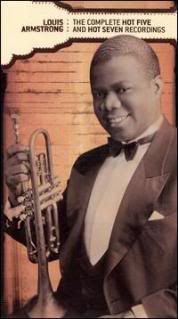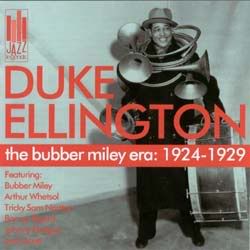
This being only the first album in The Cannonball Jazz Library, I cannot obviously say if it is the best jazz album of all time.(As with such early recordings it's not even an album per se, more a collection of the recording made by Louis Armstrong from 1925 to 1928) Such things are a matter of taste anyway. It is is undeniable however that these are some of the most important jazz recordings in the history if the genre. You just have to listen to the very first track,
Gut Bucket Blues, to see why. A swinging, bluesy number with each of the Hot Five taking their turns soloing, egged on by Louis Armstrong calling out their names.
The early recordings take a lot from old style emsemble playing but they demonstrate the direction Armstrong is heading. His vocals are to the fore early on and his playing is succint and powerful. "Heebie Jeebies" is one of the earliest examples of scat singing. "Oriental Strut" is fun yet complex. "Don't Forget To Mess Around" references the Charleston - the dance craze of the time and shows that he was an entertainer first and foremost. "Whos'it" employs a slide whistle solo, echoing Bechet's experimentation with a sarrusophone in one of his recordings - these guys were not afraid to try new things.
Disc two picks up with the original Hot Five almost a year later. "Struttin' With Some Barbecue" stands out as well as the three tracks with Lonnie Johnson on the guitar, "I'm Not Rough", "Hotter Than That" and "Savoy Blues". (For some reason the rest of the disc comprises of tracks made prior to the Hot Five recordings)
Disc Three highlights the Hot Seven lineup. Kid Ory had left to pursue his own band and Armstrong also brought in a tuba and drums. The increased quality in sound is evident as the technology of the time allowed a move away from acoustic to electric recording methods. (Note that these songs are chronologically out of order as they were recorded before the Hot Five recordings made later in 1927)It is very interesting to hear how the tuba was a straight replacement for a bass fiddle due to the sound constrictions of the latter (Check out "Alligator Blues" and "Potato Head Blues" in particular.)
Disc Four represents Louis moving on from the original Hot Five to a completely new line up that included Earl Hines on the piano and Zutty Singleton on the drums. These tracks are regarded as perhaps some of the best recordings, not only by Louis Armstrong, but of the genre itself. "West End Blues" is one of the most analysed songs in musical history.
Listening to these tracks in the chronological order they were recorded is effectively listening to a musical genius growing in stature and confidence over time and inventing a style that would not only influence jazz but 20th century popular music as a whole. The school of thought is that these tracks represent Louis Armstrong's creative peak and that he had "sold out" by the turn of the decade to become more of an entertainer. However listening to these very early recordings it's easy to see that he was always an entertainer first and foremost but that he was still, musically, a cut above everyone else. Sit back and enjoy.
Disc One covers the Hot Five recordings from November 1925 to November 1926.
1. Gut Bucket Blues
2. My Heart.
3. Yes, I'm In The Barrel
4. Come Back Sweet Papa
5. Georgia Grind
6. Heebie Jeebies
7. Cornet Chop Suey
8. Oriental Strut
9. You're Next
10. Muskrat Ramble
11. Don't Forget To Mess Around
12. I'm Gonna Gitcha
13. Droppin' Shucks
14. Whos'it
15. King Of The Zulus
16. Big Fat Ma & Skinny Pa
17. Lonesome Blues
18. Sweet Little Papa
19. Jazz Lips
20. Skid Dat-De-Dat
21. Big Butter And Egg Man
22. Sunset Cafe Stomp
23. You Made Me Love You
24. Irish Black Bottom
Disc Two The Final Hot Five Recordings September 1927 - December 1927
1. Put 'Em Down Blues
2. Ory's Creole Trombone
3. Last Time
4. Struttin' With Some Barbecue
5. Got No Blues
6. Once In A While
7. I'm Not Rough
8. Hotter Than That
9. Savoy Blues
10. He Likes It Slow
11. Gambler's Dream
12. Sunshine Baby
13. Adam And Eve Had The Blues
14. Put It Where I Can Get It
15. Washwoman Blues
16. I've Stopped My Man
17. Georgia BoBo
18. Drop That Sack
19. Cornet Chop Suey
Disc Three showcases the Hot Seven Recordings made in May 1927
1. Willie The Weaper
2. Wild Man Blues
3. Alligator Crawl
4. Potato Head Blues
5. Melancoly
6. Weary Blues
7. Twelfth Street Rag
8. S.O.L. Blues
9. Gully Low Blues
10. That's When I'll Come Back To You
11. Chicago Breakdown
12. Weary Blues
13. New Orleans Stomp
14. Wild Man Blues
15. You're A Real Sweetheart
16. Too Busy!
17. Was It A Dream
18. Last Night I Dreamed You Kissed Me
Disc Four. The Hot Five but with Louis Armstrong the only member from the original lineup. Included is his famous duet with Earl Hines, Weatherbird.
1. Fireworks
2. Skip The Gutter
3. Monday Date
4. Don't Jive Me
5. West End Blues
6. Sugarfoot Strut
7. Two Deuces
8. Squeeze Me
9. Knee Drops
10. No, Papa, No
11. Basin Street Blues
12. No One Else But You
13. Beau Koo Jack
14. Save It Pretty Mama
15. Muggle
16. Hear Me Talking To Ya
17. St. James Infirmary
18. Tight Like This
19. Weather Bird
20. I Can't Give You Anything But Love
21. Mahogany Hall Stomp
22. Knockin' A Jug

